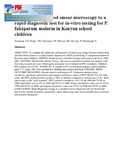Comparison of blood smear microscopy to a rapid diagnostic test for in-vitro testing for P. falciparum malaria in Kenyan school children

View/
Date
2008Author
Neumann, CG
Bwibo, NO
Siekmann, JH
McLean, ED
Browdy, B
Drorbaugh, N
Type
ArticleLanguage
enMetadata
Show full item recordAbstract
OBJECTIVE:
To compare the diagnostic performance of microscopy using Giemsa-stained thick and thin blood smears to a rapid malaria dipstick test (RDT) in detecting P. falciparum malaria in Kenyan school children.
DESIGN:
Randomised, controlled feeding intervention trial from 1998-2001.
SETTING:
Rural Embu district, Kenya. The area is considered endemic for malaria, with four rainy seasons per year. Chloroquine resistance was estimated in 80% of patients. Children had a spleen rate of 45%.
SUBJECTS:
A sample of 515 rural Kenyan primary school children, aged 7-11 years, who were enrolled in a feeding intervention trial from 1998-2001.
MAIN OUTCOME MEASURES:
Percent positive and negative P. falciparum malaria status, sensitivity, specificity and positive and negative predictive values of RDT
RESULTS:
For both years, the RDT yielded positive results of 30% in children compared to microscopy (17%). With microscopy as the "gold standard", RDT yielded a sensitivity of 81.3% in 1998 and 79.3% in 2000. Specificity was 81.6% in 1998 and 78.3% in 2000. Positive predictive value was 47.3% in 1998 and 42.6% in 2000, and negative predictive value was 95.6% in 1998 and 94.9% in 2000.
CONCLUSION:
Rapid diagnostic testing is a valuable tool for diagnosis and can shorten the interval for starting treatment, particularly where microscopy may not be feasible due to resource and distance limitations
URI
http://www.ncbi.nlm.nih.gov/pubmed/19413207http://erepository.uonbi.ac.ke:8080/xmlui/handle/123456789/15952
Citation
East Afr Med J. 2008 Nov;85(11):544-9Publisher
Department of Paediatrics, School of Public Health, University of California, Los Angeles, CA 90095-1772, USA Department of Paediatrics, University of Nairobi, Kenya.
Collections
- Faculty of Health Sciences (FHS) [10378]
